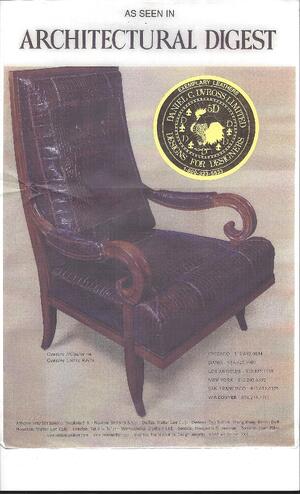 Leather furniture such as sofas, chairs, and ottomans are a popular centerpiece for an interior design. By using exotic leather, these everyday use pieces can become some truly extraordinary and worth talking about.
Leather furniture such as sofas, chairs, and ottomans are a popular centerpiece for an interior design. By using exotic leather, these everyday use pieces can become some truly extraordinary and worth talking about.
Exotic leathers have unique characteristics that stand out from more traditional cowhide—but not all exotic leathers are suitable for making chairs and ottomans. As everyday use objects, these pieces need to be both beautiful and comfortable.
Beyond comfort, the skins used for chairs and ottomans need to be very large to minimize paneling for cushions and chair backs. This is why the best two exotic skins for chairs, ottomans, and sofas would be alligator skin and ostrich skin.
Why Would You Want to Use Ostrich Skin for Chairs and Ottomans?
At first blush, ostrich leather doesn’t look nearly as exotic as materials such as alligator or python skin.
However, these skins do have some distinctive features, such as the darker quill marks that cover roughly 2/3 of each ostrich’s hide. Also, there are ostrich leg skins that have a more distinctive set of plates running down their centers—which could make an excellent decorative choice for chair armrests.
Aside from the unique quill marks, ostrich skins are plenty large enough for making seat cushions—a typical ostrich skin can provide a center square cut that’s 30” x 30” in the center, perfect for a seat cushion. A single hide can provide up to 18 square feet of leather in total.
Another practical concern that ostrich skin excels at is in providing comfort. Ostrich hides are exceptionally soft and flexible, making for extremely high-quality, luxurious seat cushions that clients will love sitting on. Also, the smoother surface of ostrich skin will make it easier to clean.
Alligator Skin: Still the King of Leather Seating Options
As good as ostrich skin is for making chairs and ottomans, alligator skin is still the king of the hill when it comes to making exotic furniture. There are many reasons why alligator skin is considered the best possible material to use for many different exotic leather projects.
First, the look of the hide makes it instantly recognizable as something completely different from cowhide. Even at a distance, the distinctive scales and plates of alligator hide can be easily distinguished from other leathers.
Next, the hide of an alligator is exceptionally soft and supple—making it perfect for providing maximum comfort as a seat cushion. Also, an average-sized alligator skin yields a center belly square cut that’s 17” (45 cm), and has a tail that’s about 16” (40 cm) wide at the top and 48” (120 cm) long—more than enough for large cushions, chair/sofa back panels, etc. Extra large alligator skins can yield square belly plates that are over 25" x 25" and tails that are over 20" at the top and run over 60" long.
There are two primary concerns when working with alligator skin for chairs and ottomans, however:
- Acquiring Enough Skins to Complete Your Project. While individual alligator skins can be very large, finding the kind of high-grade skins you need to fill your panels can be very difficult and costly. Large alligator skin is in high demand for the handbag industry and the supply is very limited.
- Arranging Plate Patterns. The flank, tail, and belly plates of an alligator’s hide have different looks to them. When planning out your panels for a chair or ottoman, it’s important to consider what kind of plates you want to display on each part of the chair, and in what orientation. Larger products such as sofas add even more challenge for ordering hides and planning panel layouts.
If you can get your hands on alligator leather and have budgeted for it, it’s well worth the cost and effort needed to acquire it. Even though the actual planning for how you arrange your panels can be a challenge, the leather itself is very easy to work with, and can produce a stunning final product.
As a high-fashion material, alligator skin is worth more than its weight in gold.
Need some help with finding the right exotic leathers for your next interior design project? Get the lowdown on what leathers would be best for your project today!



